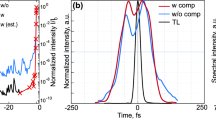Abstract
The paper has studied the influence of target material and thickness on energy and angular distributions of the protons generated by using an 800 nm, 60 fs, 0.24 J laser pulse to irradiate solid target foils. The results show that the initial density and thickness of the targets will affect the formation of the acceleration sheath fields in the target normal direction. For the same target thickness, using lower density target materials can obtain a higher proton maximum energy. However, lower density targets tend to be deformed due to the shock waves launched by the laser pulses, making the proton spatial distribution more divergent.
Similar content being viewed by others
References
Borghesi M, Campbell D H, Schiavi A, et al. Electric field detection in laser-plasma interaction experiments via the proton imaging technique. Phys Plasmas, 2002, 9: 2214–2220
Kodama R, Norreys P A, Mima K, et al. Fast heating of ultrahigh-density plasma as a step towards laser fusion ignition. Nature, 2001, 412: 798–802
Bulanov S S, Brantov A, Bychenkov V Y, et al. Accelerating protons to therapeutic energies with ultra-intense ultra-clean and ultra-short laser pulses. Med Phys, 2008, 35: 1770–1776
Zhang X M, Shen B F, Li X M, et al. Efficient GeV ion generation by ultraintense circularly polarized laser pulse. Phys Plasmas, 2007, 14: 123108
Yan X Q, Lin C, Sheng Z M, et al. Generating high-current monoenergetic proton beams by a circularly polarized laser pulse in the phase-stable acceleration regime. Phys Rev Lett, 2008, 100: 135003
Macchi A, Cattani F, Liseykina T V, et al. Laser acceleration of ion bunches at the front surface of overdense plasmas. Phys Rev Lett, 2005, 94: 165003
Kaluza M, Schreiber J, Santala M I K, et al. Influence of the laser prepulse on proton acceleration in thin-foil experiments. Phys Rev Lett, 2004, 93: 045003
Zhang X M, Shen B F, Yu M Y, et al. Effect of plasma temperature on electrostatic shock generation and ion acceleration by laser. Phys Plasmas, 2007, 14: 113108
Silva L O, Marti M, Davies J R, et al. Proton shock acceleration in laser-plasma interactions. Phys Rev Lett, 2004, 92: 015002
D'Humières E, Lefebvre E, Gremillet L, et al. Proton acceleration mechanisms in high-intensity laser interaction with thin foils. Phys Plasmas, 2005, 12: 062704
Wang X F, Nemoto K, Nayuki T, et al. Effect of plasma peak density on energetic proton emission in ultrashort high-intensity laser-foil interactions. Phys Plasmas, 2005, 12: 113101
Holkundkar A R, Gupta N K. Effect of initial plasma density on laser induced ion acceleration. Phys Plasmas, 2008, 15: 123104
Chen M, Sheng Z M, Dong Q L, et al. Ion acceleration by colliding electrostatic shock waves in laser-solid interaction. Phys Plasmas, 2007, 14: 113106
Chen M, Sheng Z M, Dong Q L, et al. Collisionless electrostatic shock generation and ion acceleration by ultraintense laser pulses in overdense plasmas. Phys Plasmas, 2007, 14: 053102
Wilks S C, Langdon A B, Cowan T E, et al. Energetic proton generation in ultra-intense laser-solid interactions. Phys Plasmas, 2001, 8: 542–549
Nakamura T, Fukuda Y, Yogo A, et al. High energy negative ion generation by Coulomb implosion mechanism. Phys Plasmas, 2009, 16: 113106
Murakami M, Mima K. Efficient generation of quasimonoenergetic ions by Coulomb explosions of optimized nanostructured clusters. Phys Plasmas, 2009, 16: 103108
Esirkepov T, Borghesi M, Bulanov S V, et al. Highly efficient relativisticion generation in the laser-piston regime. Phys Rev Lett, 2004, 92: 175003
Santos J J, Debayle A, Nicolaï Ph, et al. Fast-electron transport and induced heating in aluminum foils. Phys Plasmas, 2007, 14: 103107
Manclossi M, Santos J J, Batani D, et al. Study of ultraintense laser-produced fast-electron propagation and filamentation in insulator and metal foil targets by optical emission diagnostics. Phys Rev Lett, 2006, 96: 125002
Santos J J, Amiranoff F, Baton S D, et al. Fast electron transport in ultraintense laser pulse interaction with solid targets by rear-side self-radiation diagnostics. Phys Rev Lett, 2002, 89: 025001
Malka G, Miquel J L. Experimental confirmation of ponderomotive-force electrons produced by an ultrarelativistic laser pulse on a solid target. Phys Rev Lett, 1996, 77: 75–78
Wilks S C, Kruer W L, Tabak M, et al. Absorption of ultra-intense laser pulses. Phys Rev Lett, 1992, 69: 1383–1386
Fuchs J, Antici P, D'Humières E, et al. Laser-driven proton scaling laws and new paths towards energy increase. Nat Phys, 2006, 2: 48–54
Mora P. Plasma expansion into a vacuum. Phys Rev Lett, 2003, 90: 185002
Honrubia J, Kaluza M, Schreiber J, et al. Laser-driven fast-electron transport in preheated foil targets. Phys Plasmas, 2005, 12: 052708
Flacco A, Sylla F, Veltcheva M, et al. Dependence on pulse duration and foil thickness in high-contrast-laser proton acceleration. Phys Rev E, 2010, 81: 036405
Lindau F, Lundh O, Persson A, et al. Laser-accelerated protons with energy-dependent beam direction. Phys Rev Lett, 2005, 95: 175002
Lundh O, Lindau F, Persson A, et al. Influence of shock waves on laser-driven proton acceleration. Phys Rev E, 2007, 76: 026404
Brambrink E, Roth M, Blazevic A, et al. Modeling of the electrostatic sheath shape on the rear target surface in short-pulse laser-driven proton acceleration. Laser Part Beams, 2006, 24: 163–168
Xu M H, Li Y T, Liu F, et al. Enhancement of ion generation in low-contrast laser-foil interactions by defocusing. Acta Phys Sin, 2011, 60: 045204
Author information
Authors and Affiliations
Corresponding authors
Additional information
Contributed by CHEN JiaEr (CAS Academician) & ZHANG Jie (CAS Academician
Rights and permissions
About this article
Cite this article
Su, L., Liu, B., Lin, X. et al. The influence of target material and thickness on proton energy and angular distribution. Sci. China Phys. Mech. Astron. 56, 457–461 (2013). https://doi.org/10.1007/s11433-012-4961-9
Received:
Accepted:
Published:
Issue Date:
DOI: https://doi.org/10.1007/s11433-012-4961-9



